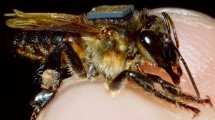Abstract
Behavioral studies often aim to perform specific actions on focal individuals and could benefit from automated procedures. With this paper, our goal is to demonstrate to ecologists that building a selective, automated device triggered by radio frequency identification detection (RFID) running on a battery is easy and affordable (~ 100 Euros). We provide a step-by-step description of how to build such an RFID triggered trap for small animals. We built and tested our selective traps in a colony of 300 captive bats, flying in a 40-m-diameter dome. Our device proved successful in trapping focal individuals using RFID identification while recording every single visit to the trap-feeder. Our guide not only provides information for building RFID-triggered traps, but also offers a general framework for building any device triggered by RFID and can thus help build tailored setups matching specific studies requirement. Home-made selective device using RFID detection have a great potential in opening-up exciting new possibilities for a wide range of studies on animals, ranging from trapping specific individuals, to automatically monitoring activities at the nest-box, or supplementing specific individuals in a population.








Similar content being viewed by others
References
Adelman JS, Moyers SC, Farine DR, Hawley DM (2015) Feeder use predicts both acquisition and transmission of a contagious pathogen in a North American songbird. Proc Biol Sci 282 (1815):20151429
Ambrož M (2017) Raspberry Pi as a low-cost data acquisition system for human powered vehicles. Measurement 100:7–18
Aplin LM, Farine DR, Morand-Ferron J, Cole EF, Cockburn A, Sheldon BC, Sih A (2013) Individual personalities predict social behaviour in wild networks of great tits (Parus major). Ecol Lett 16:1365–1372
Aplin LM, Farine DR, Morand-Ferron J, Cockburn A, Thornton A, Sheldon BC (2015) Experimentally induced innovations lead to persistent culture via conformity in wild birds. Nature 518:538–541
Bridge ES, Bonter DN (2011) A low-cost radio frequency identification device for ornithological research. J Field Ornithol 82:52–59
Demeyrier V, Charmantier A, Lambrechts MM, Grégoire A (2017) Disentangling drivers of reproductive performance in urban great tits: a food supplementation experiment. J Exp Biol 220:4195–4203
Farine DR, Spencer KA, Boogert NJ (2015) Early-life stress triggers juvenile zebra finches to switch social learning strategies. Curr Biol 25:2184–2188
Fleming TH (1988) The short-tailed fruit bat: a study in plant-animal interactions. University of Chicago Press, Chicago
Hinde CA (2006) Negotiation over offspring care?—a positive response to partner-provisioning rate in great tits. Behav Ecol 17:6–12
König B, Lindholm AK, Lopes PC, Dobay A, Steinert S, Buschmann FJU, (2015) A system for automatic recording of social behavior in a free-living wild house mouse population. Animal Biotelemetry 3:39
Lendvai ÁZ, Akçay Ç, Weiss T, Haussmann MF, Moore IT, Bonier F (2015) Low cost audiovisual playback and recording triggered by radio frequency identification using Raspberry Pi. PeerJ 3:e877
Pasquali V, D’Alessandro G, Gualtieri R, and Leccese F (2017) A new data logger based on Raspberry-Pi for Arctic Notostraca locomotion investigations. Measurement 110:249-256
Prinz ACB, Taank VK, Voegeli V, Walters EL (2016) A novel nest-monitoring camera system using a Raspberry Pi micro-computer. J Field Ornithol 87:427–435
Psorakis I, Roberts SJ, Rezek L, Sheldon BC (2012) Inferring social network structure in ecological systems from spatio-temporal data streams. J R Soc Interface 9:3055–3066
Whytock RC, Christie J (2017) Solo: an open source, customizable and inexpensive audio recorder for bioacoustic research. Methods Ecol Evol 8:308–312
Acknowledgments
We are very thankful to the Papiliorama, for allowing us to study their bat colony under such excellent research conditions. We are especially thankful to the technical team, for installing electricity and helping with installing the traps, Michel Ruegger, Tiago Marques, and Erland Mühlheim. We warmly thank Idonus, Paul Buckley, and Robert Accardi, from Priority 1 design. We also thank Lucie Masseboeuf for her help with the bats. Finally, we are thankful to the reviewers who provided helpful comments on a previous version of the manuscript.
Funding
This study was supported by grants from the Swiss National Science Foundation n ° PP00P3_139011 and n° PP00P3_165840 to FH.
Author information
Authors and Affiliations
Contributions
MM, AF, NF, and FH conceived the ideas.
MM and AF designed the methodology.
MM and AF build the set-up.
MM wrote the manuscript, with contributions from all authors.
All the authors accepted the final version of the manuscript.
Corresponding author
Ethics declarations
Ethical approval
This study was performed under the authorization 2015_43_FR, delivered by the veterinary office of the Canton Fribourg, Switzerland after examination by its ethical committee. All applicable international, national, and/or institutional guidelines for the use of animals were followed.
Conflict of interest
The authors declare that they have no conflict of interest.
Additional information
Communicated by L. Z. Garamszegi
Publisher’s note
Springer Nature remains neutral with regard to jurisdictional claims in published maps and institutional affiliations.
Fabrice Helfenstein and Nicolas Fasel shared last authorship
Electronic supplementary material
ESM 1
(DOCX 23 kb)
Rights and permissions
About this article
Cite this article
Meniri, M., Farley, A., Helfenstein, F. et al. A guide for ecologists to build a low-cost selective trap using radio frequency identification detection. Behav Ecol Sociobiol 73, 80 (2019). https://doi.org/10.1007/s00265-019-2675-y
Received:
Revised:
Accepted:
Published:
DOI: https://doi.org/10.1007/s00265-019-2675-y




